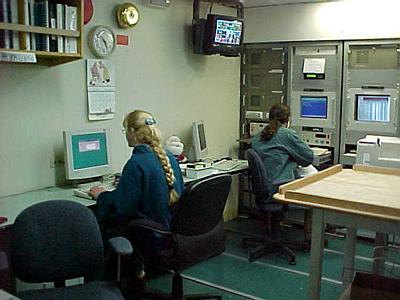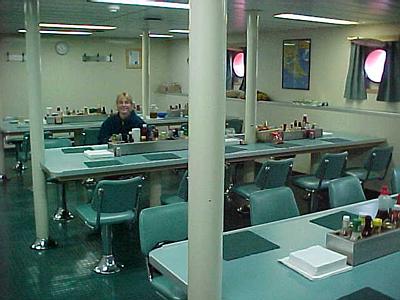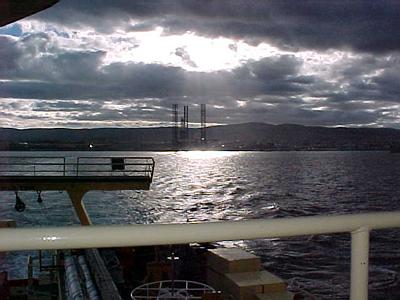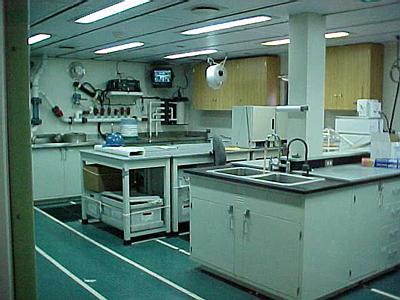4 March, 2000
Tour of Gould; Leave Punta Arenas!
Question 14: What does the R.V. that comes before the Laurence M. Gould's
name stand for?
Continued...
The deck level has all the lab spaces--for us this is just our ride to
Antarctica, but for many other scientists this is the destination, and they do
their work on board. The computer lab is on this level with common-use
computers that can access our ship email. Internet is not available and email
operates in an unusual way. All mail sent from individual accounts on board
the ship is held by the ship computers until the computer techs send it out in
a batch to a central computer in Denver, Colorado, twice a day. From there,
it goes to its addressed destination. There are many places for the system to
break down, and it is not as reliable as sending a normal email message.
Email coming to our ship accounts goes to the Denver computer where it is
collected until the computer techs on the ship download it, again, twice a
day.
The laundry is on the deck level, as is the galley (cafeteria). All the
washers and dryers are bolted down and we have been asked not to wash clothes
when the seas are bad. It confuses the machines' fill-level sensors and they
leak soapy water everywhere. The galley is similarly outfitted. There are
fixed tables (with lips) and chairs, rubber mats to keep plates and glasses
from sliding, and high bins for condiments. Food is served cafeteria-style
and is very good. Since we are coming from Chile there are lots of fresh
vegetables, fruits and salads. Breakfast is served 07:30-08:30, lunch
11:30-12:30, and dinner 17:30-18:30. We are on a 24-hour clock. This level
has the main deck of the Gould. While in transit there is just storage on the
deck. Once we reach Palmer the deck will be reconfigured to serve as a
platform for the 10-day scientific cruise that will follow. Below the deck
level is the hold, the first level with no outside access. There are two
berthing vans attached here as well as lots of other stored items. I will be
looking at the crew areas on the way back from Palmer Station.
Most interior hatches (doors) have heavy-duty springs and close
automatically. There are a few that it is structurally important to close
off if there is a leak, and these seal with wheels and bars. Outside hatches
have high sills; some are up to my knee. While we are underway they must be
dogged down. This means that in addition to the regular door latch, the
manual latches (dogs) at top and bottom of the door have to be turned to seal
the door. They are not locks, they just make sure that they doors stay shut
no matter how extreme the ship's movement. Doors also have hold-fasts that
they hook into if they need to be open. While underway, very few doors are
left open.
We spent most of the night puttering around by Punta Arenas, and by noon the
problem was solved. We left port after 3pm with the technician on board. He
will stay with us to the end of the strait as will the local pilot who takes
the ship out of the inshore area. The same boat will take both of them back
to P.A. There are young Giant Petrels flying around the ship, groups of
Magellanic Penguins swimming and diving and lots of Southern Terns feeding at
the surface of the water. Some dolphins were spotted bow surfing. There are
also man-made objects in evidence. Further north in the strait there was a
whole forest of oil platforms. The flames burning off natural gas just kept
appearing over the horizon until there were about 15 of the rigs visible. The
sea in the protected area of the strait is very calm, and it is possible to go
to sleep without even noticing that we are no longer anchored (other than the
engine hum.)
Answer 13: The Southern Ocean. It became the official name very recently.
The other popularly used name was the Antarctic Ocean.

Computer Lab

Joanna Hubbard coming out of the 01 level hatch.

Katrin in the galley.

Last view of Punta Arenas til May!

Laboratory space on R.V. Gould.

Contact the TEA in the field at
.
If you cannot connect through your browser, copy the
TEA's e-mail address in the "To:" line of
your favorite e-mail package.
|
